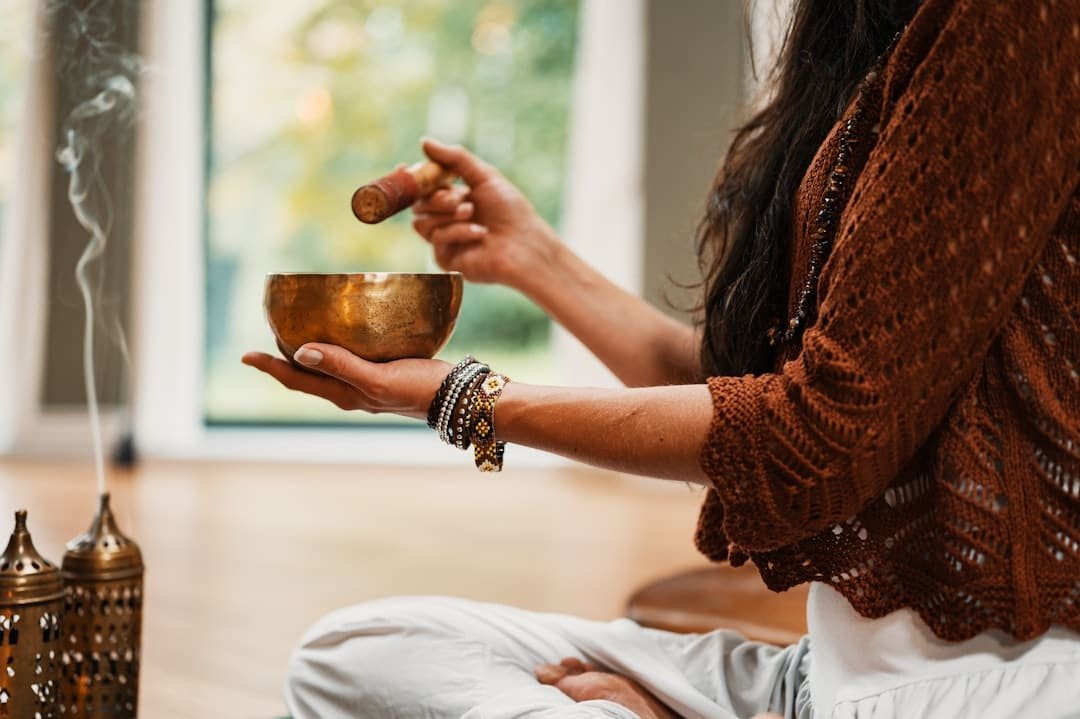This post may contain affiliate links. When you purchase through links on our site, we may earn an affiliate commission.
When I think about creating a warm and inviting space, I envision a sanctuary that feels like a gentle embrace. The first step in this process is to declutter my surroundings. I find that a clean and organized environment allows my mind to relax and focus.
I take the time to remove any unnecessary items that may distract me, leaving only those that bring me joy or serve a purpose. This act of decluttering not only clears physical space but also creates mental clarity, making it easier for me to engage in mindfulness practices. Next, I pay attention to the colors and textures in my space.
I often choose warm hues like soft yellows, earthy browns, and calming greens, as they evoke feelings of comfort and tranquility. Adding plush textiles, such as cozy blankets and cushions, enhances the inviting atmosphere. I also incorporate personal touches, like photographs or artwork that resonate with me, creating a sense of belonging.
By curating my environment in this way, I transform it into a haven where I can retreat from the chaos of daily life and nurture my well-being.
Key Takeaways
- Use warm and inviting colors and textures to create a cozy atmosphere in your space.
- Invest in comfortable seating options that promote relaxation and encourage conversation.
- Soft lighting and candles can help set a calming and soothing mood in the room.
- Choose background music or sounds that promote relaxation and mindfulness.
- Incorporate breathwork and mindfulness techniques to promote a sense of calm and presence in the space.
Finding Comfortable Seating
Comfortable seating is essential for creating an inviting space where I can unwind and engage in self-care practices. I often explore various seating options, from plush armchairs to floor cushions, to find what feels best for me. A well-cushioned chair allows me to sink in and relax, while a floor cushion invites a more grounded experience.
I appreciate the versatility of different seating arrangements, as they can influence my mood and level of comfort. In addition to comfort, I consider the ergonomics of my seating choices. I want to ensure that my posture is supported, especially during longer periods of meditation or reflection.
I often experiment with different positions—sitting cross-legged on the floor or reclining in a chair—to discover what feels most natural for my body. Ultimately, finding the right seating is about creating a space where I can feel at ease, allowing me to fully immerse myself in the practices that nourish my soul.
Setting the Mood with Soft Lighting and Candles

Lighting plays a crucial role in establishing the ambiance of my space. I gravitate towards soft, diffused lighting that creates a warm glow rather than harsh overhead lights. I often use lamps with adjustable brightness or string lights to achieve this effect.
The gentle illumination helps me feel more relaxed and encourages a sense of calm as I transition into my mindfulness practices. Candles are another favorite element of mine when it comes to setting the mood. The flickering flame not only provides a soothing light but also adds an aromatic dimension to my space.
I enjoy experimenting with different scents—lavender for relaxation, citrus for invigoration, or sandalwood for grounding—each contributing to the overall atmosphere. As I light a candle, I take a moment to appreciate its beauty and the warmth it brings, allowing it to serve as a focal point during my mindfulness sessions.
Choosing the Right Background Music or Sounds
| Factors to Consider | Importance |
|---|---|
| Genre of the Content | High |
| Emotional Tone | High |
| Volume Levels | Medium |
| Relevance to the Audience | High |
| Consistency with Brand Image | High |
The auditory landscape of my space is just as important as its visual elements. I find that the right background music or sounds can significantly enhance my mindfulness experience. Depending on my mood or intention for the day, I curate playlists that range from soothing instrumental music to nature sounds like flowing water or rustling leaves.
These sounds create an immersive environment that helps me focus and relax. I also enjoy exploring guided meditations or soundscapes designed specifically for mindfulness practices. The gentle guidance of a meditation instructor can help me stay present and engaged, while ambient sounds transport me to serene landscapes.
Whether it’s the sound of ocean waves or soft chimes, these auditory elements enrich my practice and allow me to connect more deeply with myself.
Incorporating Breathwork and Mindfulness Techniques
Breathwork is an integral part of my mindfulness practice, serving as a bridge between my body and mind. I often begin my sessions by taking a few deep breaths, allowing myself to become aware of the rhythm of my breath. This simple act grounds me in the present moment and helps me release any tension or distractions from my day.
As I focus on my breath, I find that it becomes easier to let go of racing thoughts and cultivate a sense of inner peace. Incorporating mindfulness techniques into my routine further enhances my experience. I practice techniques such as body scanning or mindful observation, which encourage me to tune into my physical sensations and emotions without judgment.
These practices help me cultivate self-awareness and foster a deeper connection with myself. By integrating breathwork and mindfulness techniques into my daily life, I create a nurturing space where I can explore my thoughts and feelings with compassion.
Practicing Gratitude and Reflection

The Power of Reflection
Whether it’s a warm cup of tea or a conversation with a friend, acknowledging these small blessings helps me foster a positive mindset. I often keep a gratitude journal where I jot down my reflections. Writing down what I’m grateful for serves as a tangible reminder of the beauty in everyday life.
Finding Comfort in Challenging Times
On days when I feel overwhelmed or stressed, revisiting these entries brings me back to a place of appreciation and contentment. This practice encourages me to celebrate life’s simple pleasures and reinforces the importance of mindfulness in nurturing a grateful heart.
Cultivating a Grateful Heart
By incorporating gratitude into my daily routine, I’ve come to realize that it’s the small things in life that bring me the most joy. This mindset shift has allowed me to approach life with a sense of wonder and appreciation, rather than focusing on what’s lacking.
Exploring Guided Visualization and Imagery
Guided visualization is another powerful tool in my mindfulness toolkit. Through this practice, I can transport myself to serene landscapes or envision positive outcomes in various aspects of my life. As I close my eyes and follow along with guided imagery recordings, I allow myself to fully immerse in the experience—feeling the warmth of the sun on my skin or hearing the gentle rustle of leaves in the breeze.
This technique not only enhances relaxation but also fosters creativity and inspiration within me. By visualizing my goals or dreams, I create a mental roadmap that motivates me to take action in my waking life. The vivid imagery helps me connect with my aspirations on a deeper level, making them feel more attainable.
Guided visualization has become an essential part of my practice, allowing me to explore new possibilities while cultivating inner peace.
Embracing Stillness and Silence
In our fast-paced world, embracing stillness and silence can be challenging yet profoundly rewarding. I’ve learned that carving out moments of quietude allows me to reconnect with myself on a deeper level. Whether it’s sitting in silence for a few minutes or taking a leisurely walk without distractions, these moments provide an opportunity for reflection and introspection.
During these periods of stillness, I often find clarity emerging from within. My mind begins to settle, and insights arise that may have been obscured by the noise of daily life. Embracing silence has taught me the value of listening—not just to external sounds but also to the whispers of my own heart and intuition.
In this sacred space of quietude, I discover the richness of being present with myself, fostering a deeper sense of connection and understanding. In conclusion, creating an inviting space for mindfulness is an ongoing journey that involves thoughtful consideration of various elements—from the physical environment to auditory experiences and inner practices. By cultivating warmth through decor, finding comfortable seating, setting the mood with lighting and sound, incorporating breathwork and gratitude, exploring visualization techniques, and embracing stillness, I nurture an environment that supports my well-being and personal growth.
Each aspect contributes to a holistic approach that allows me to engage fully in mindfulness practices while fostering a deeper connection with myself and the world around me.
Looking for some comforting recipes to enjoy after your winter indoor meditation session? Check out this article on A to Z Cozy Corner for delicious and cozy meal ideas. Whether you’re in the mood for a hearty soup or a warm dessert, these recipes will help you relax and unwind after a peaceful meditation practice.
FAQs
What are some winter indoor meditation practices?
Some winter indoor meditation practices include breath awareness meditation, body scan meditation, loving-kindness meditation, and visualization meditation. These practices can help cultivate mindfulness, reduce stress, and promote overall well-being during the winter months.
How can I create a comfortable meditation space indoors during the winter?
To create a comfortable meditation space indoors during the winter, you can use soft cushions or a meditation mat, dim lighting, and a cozy blanket. You may also want to incorporate elements such as candles, essential oils, or calming music to enhance the ambiance.
What are the benefits of practicing meditation indoors during the winter?
Practicing meditation indoors during the winter can help alleviate seasonal affective disorder (SAD), reduce anxiety and depression, improve focus and concentration, and promote a sense of inner peace and tranquility. It can also provide a respite from the cold weather and offer a sense of warmth and comfort.
How can I stay motivated to maintain a regular indoor meditation practice during the winter?
To stay motivated to maintain a regular indoor meditation practice during the winter, you can set specific goals, establish a consistent schedule, find a meditation buddy or community for support, and explore different meditation techniques to keep your practice engaging and enjoyable. Additionally, reminding yourself of the benefits of meditation can help reinforce your motivation.

 using WordPress and
using WordPress and 
No responses yet